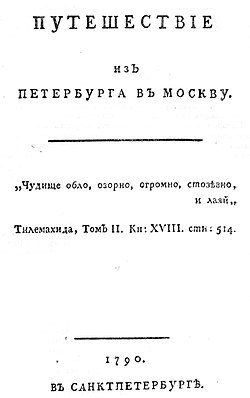Journey from St. Petersburg to Moscow

Journey From Petersburg to Moscow (in Russian: Путешествие из Петербурга в Москву), published in 1790, was the most famous work by the Russian writer Aleksander Nikolayevich Radishchev.
The work, often described as a Russian Uncle Tom's Cabin, is a polemical study of the problems in the Russia of Catherine the Great: serfdom, the powers of the nobility, the issues in government and governance, social structure and personal freedom and liberty. The book starts from an epigraph about The Beast who is "enormous, disgusting, a-hundred-maws and barking" meaning Russian Empire.
The book was immediately banned and Radishchev sentenced, first to death, then to banishment in eastern Siberia. It was not freely published in Russia until 1905.
In the book, Radishchev takes an imaginary journey between Russia's two principal cities; each stop along the way reveals particular problems for the traveller through the medium of story telling. In Petersburg, the narrator’s story begins at an inn where the proprietor is too lazy to harness his underfed horses for a carriage. Eventually getting on the road, he encounters a man trying to sell genealogical papers to nobles seeking to increase their rank, and a poor peasant laboring on a Sunday. He goes on to satirize Catherine’s favorite, Viceroy Potemkin, with an anecdote about his appetite for oysters and the absurd lengths his servant would go to get them.[1]
Likely the most famous scene is the narrator’s dream of being a “tsar, shah, khan, king, bey, nabob, sultan, or holder of some such dignity, sitting in regal power on a throne.” At his most minor expression, the courtiers sigh, frown, light up with joy. Seeing this obsequiousness, the narrator-tsar orders the invasion of a distant country, which he is assured will submit to his mere reputation. Suddenly, the female figure of Truth appears, offering him clearsightedness and defending the rights of dissenters. After being reprimanded, the king is overcome by visions of his own brutality, the sins of his court, and the general disrepair of the empire. In a final moment of self-reproach and guilt, inspired by the gaudy and wasteful palace he’s built, the narrator is woken from his dream in agitation.[2]
Considered by many to be the seminal radical text of the 18th century, A Journey continued to influence Russian political thought even after its condemnation. As the progenitor of public liberal discourse in Russia, Radischev is considered an ancestor of all major subversive literature written in the 19th and 20th centuries.[3]
The book itself represented a challenge to Catherine in Russia, despite the fact that Radishchev was no revolutionary: merely an observer of the ills he saw within Russian society and government at the time.
Published during the period of the French Revolution, the book borrows ideas and principles from the great philosophers of the day relating to an enlightened outlook and the concept of Natural Law.
References
- Radishchev, Alexandr Nikolaevich (1958) [1790]. A Journey From St. Petersburg to Moscow. Cambridge: Harvard University Press.
Majic
External links
- Time Magazine story on a 2007 re-tracing of Radishchev's journey
- Radishchev, Alexander (15 February 2009). Chapter 22: A Journey From St. Petersburg To Moscow: Excerpts. (in: Riha, Thomas, ed., Readings in Russian Civilization, Volume 2: Imperial Russia, 1700-1917): University of Chicago Press. pp. 261+. Retrieved 16 November 2014.
{{cite book}}: CS1 maint: location (link) - Smith, Douglas (2011). Alexander Radishchev's Journey from St. Petersburg to Moscow and the Limits of Freedom of Speech on the Reign of Catherine the Great. (in: ed. Elizabeth Powers, Freedom of Speech: The History of an Idea ): Rowman & Littlefield. pp. 61–78. Retrieved 16 November 2014.
